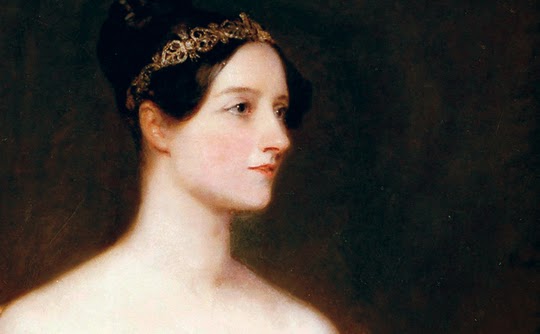Happy Ada Lovelace Day!
Who Was Ada Lovelace?The woman most often known as ‘Ada Lovelace’ was born Ada Gordon in 1815, sole child of the brief and tempestuous marriage of the erratic poet George Gordon, Lord Byron, and his mathematics-loving wife Annabella Milbanke.
Fearing that Ada would inherit her father’s volatile ‘poetic’ temperament, her mother raised her under a strict regimen of science, logic, and mathematics. Ada herself from childhood had a fascination with machines– designing fanciful boats and steam flying machines, and poring over the diagrams of the new inventions of the Industrial Revolution that filled the scientific magazines of the time.At the age of 19 she was married to an aristocrat, William King; when King was made Earl of Lovelace in 1838 his wife became Lady Ada King, Countess of Lovelace. She is generally called Ada Lovelace, which is a little incorrect but saves confusion! She had three children.In 1833, Lovelace’s mentor, the scientist and polymath Mary Sommerville, introduced her to Charles Babbage, the Lucasian Professor of Mathematics who had already attained considerable celebrity for his visionary and perpetually unfinished plans for gigantic clockwork calculating machines. Charles Babbage and Ada Lovelace both had somewhat unconventional personalities and became close and lifelong friends. Babbage described her as “that Enchantress who has thrown her magical spell around the most abstract of Sciences and has grasped it with a force which few masculine intellects could have exerted over it,” or an another occasion, as “The Enchantress of Numbers”.The Analytical EngineLovelace was deeply intrigued by Babbage’s plans for a tremendously complicated device he called the Analytical Engine, which was to combine the array of adding gears of his earlier Difference Engine with an elaborate punchcard operating system. It was never built, but the design had all the essential elements of a modern computer.In 1842 Lovelace translated a short article describing the Analytical Engine by the italian mathematician Luigi Menabrea, for publication in England. Babbage asked her to expand the article, “as she understood the machine so well”. The final article is over three times the length of the original and contains several early ‘computer programs,’ as well as strikingly prescient observations on the potential uses of the machine, including the manipulation of symbols and creation of music. Although Babbage and his assistants had sketched out programs for his engine before, Lovelace’s are the most elaborate and complete, and the first to be published; so she is often referred to as “the first computer programmer”. Babbage himself “spoke highly of her mathematical powers, and of her peculiar capability — higher he said than of any one he knew, to prepare the descriptions connected with his calculating machine.”Ada Lovelace died of cancer at 36, a few short years after the publication of “Sketch of the Analytical Engine, with Notes from the Translator."The Analytical Engine remained a vision, until Lovelace’s notes became one of the critical documents to inspire Alan Turing’s work on the first modern computers in the 1940s. Her thwarted potential, and her passion and vision for technology, have made her a powerful symbol for modern women in technology.-Source
- Ada Lovelace Day: 5 things you need to know about being a woman in STEM
- Ada Lovelace Day celebrates women in technology
- Ada Lovelace Day: A celebration of women in science and technology
Links!
- Libraries, Books, & Authors
- Best literary birthday cakes Sounds like a great way to celebrate your favorite librarian! ;)
- The Harry Potter Generation Has Been Waiting for Malala
- Net & Tech
- Two Teenage Girls Have Invented the Most Powerful Video Game of the Year
- Upcoming Battery Will Charge Phones And Electric Cars in Minutes
- Science
- Wasteful research isn’t "Government-funded basic research often sounds strange, and it’s easy to make fun of out of context, but the impacts can be huge. For example, Golden Goose Award-winning rat-massage research led to greatly improved treatment for premature human babies..."
- Authority Issues
- Police: Nearly 50 arrested in Ferguson protests
- Little Girl Points Crayon at Classmate, School Makes Her Sign Contract Promising Not to Kill Anyone Craziness...
- Other
- Family delivering news of son's death shocked when he answers door And, no, he wasn't a zombie.
- Are Tiny Houses a Viable Affordable Housing Solution?
- Medical Bills: Even Worse Than You Thought
- Dear World: Let’s Stop Giving Our Crap to the Poor "There’s nothing wrong with used or second-hand. It’s often my first and favorite choice. Many organizations and ministries depend on used gifts. But if we give used, it should be our best. I’m not saying when we clean out older clothes or toys or things we don’t use any longer and donate them–that this is wrong. I am saying if we give it away, it should be something we would use ourselves."
- New Hampshire Republican: Rep. Ann McLane Kuster "is as ugly as sin" "New Hampshire State Rep. Steve Vaillancourt wrote a long blog post predicting the outcome of the race in the state's 2nd Congressional District on one factor: incumbent Democratic Rep. Ann McLane Kuster's looks....'Annie Kuster looks more like a drag queen than most men in drag,' he concludes."
- 50 Years Ago Today, MLK Was Honored for His Dedication to Peace




Comments
Post a Comment